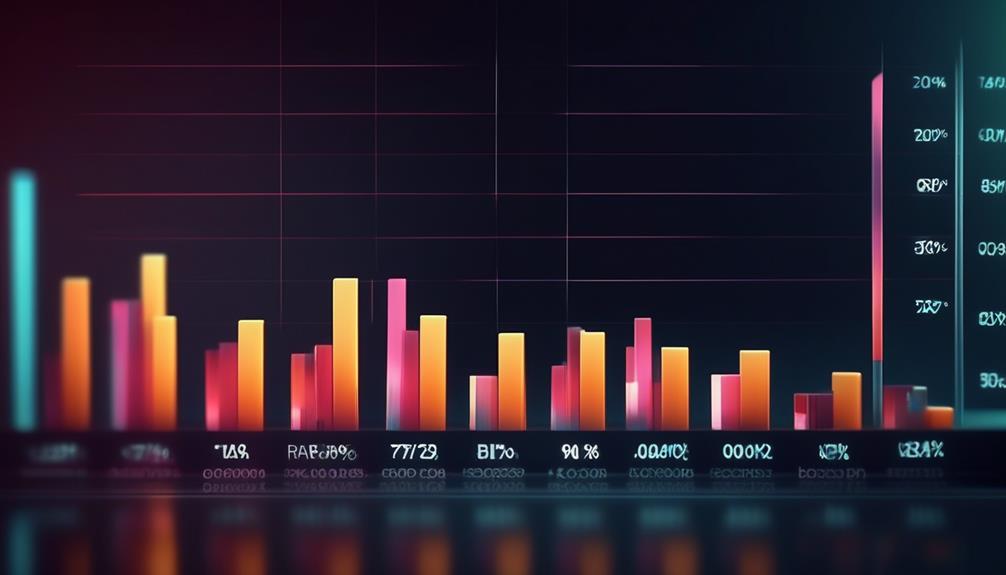Email marketing is often likened to casting a wide net in a vast ocean of potential customers. Just as fishermen eagerly anticipate a successful catch, marketers eagerly await positive responses from their email campaigns.
But what exactly constitutes a good response rate? Is it 5%, 10%, or even higher? The answer isn’t always straightforward, and it can be influenced by various factors.
Let’s explore the intricacies of determining a good response rate for email marketing and how it can impact the success of our campaigns.
Key Takeaways
- Email response rates can vary based on factors such as email type, industry, and target audience.
- Aiming for around 10% is a good benchmark for a response rate.
- Segmenting the email list and using platforms that track response rates are important for measuring and setting realistic goals.
- Higher response rates contribute to lead generation and sales, increasing the overall ROI of email marketing.
Understanding Email Response Rates
Based on industry standards and our own email marketing analytics, we’ve found that understanding email response rates is crucial for optimizing our campaigns and maximizing our ROI. The email response rates can vary significantly based on the type of email and industry. Aiming for around 10% is a good benchmark to start with. However, it’s essential to consider the email platform, content, and target audience when measuring and setting realistic response rate goals.
To establish a baseline, the average open rate (15-25%) can be used as a starting point. Segmenting the email list for testing and measuring response rates using platforms that track this statistic is imperative. Higher response rates play a pivotal role in lead generation and sales, thus contributing to the overall ROI of email marketing.
Therefore, grasping the nuances of email response rates is fundamental for gauging the effectiveness of our marketing efforts. By understanding these rates, we can better comprehend the impact that email marketing delivers and can strategically optimize our campaigns for greater success.
Benchmarks for Email Response Rates

To establish effective benchmarks for email response rates, we analyze industry standards and our own email marketing analytics to determine realistic goals. When setting benchmarks for email response rates, it’s essential to consider the type of email, industry, and target audience. A good starting point is to aim for a response rate of around 10%, although this can vary based on factors such as the email platform used and the content of the emails. To provide a clearer understanding, the table below outlines the average email response rates and provides insight into how to improve these rates.
| Response Rate | Description | Strategies to Improve |
|---|---|---|
| 10% | Good | Segment your list, provide value, personalize content |
| 15-25% | Average | Use email platforms that track response rates, segment your email list for testing and analysis |
| – | Cold Email Response Rate | Segment your list, improve your response rate, click-through rate |
Factors Affecting Response Rates
Understanding the factors that influence email response rates is crucial for devising targeted and effective email marketing strategies. Several key elements can significantly impact the response rates of email campaigns:
- Open Rates: The percentage of recipients who open an email is a critical factor in determining the response rate. Higher open rates often lead to increased engagement and ultimately a better response rate.
- Subject Line: The subject line plays a pivotal role in capturing the recipient’s attention. A compelling and relevant subject line can lead to higher open rates and, consequently, a better response rate.
- Type of Email: The type of email being sent, whether it’s a promotional offer, newsletter, or personalized communication, can have a significant impact on the response rate. Tailoring the email type to the preferences of the target audience can improve response rates.
Understanding these factors and their impact on response rates helps marketers make informed decisions when crafting email strategies. Employing best practices, such as A/B testing different subject lines and content, can further enhance the effectiveness of email marketing initiatives.
Strategies for Improving Response Rates

Improving email marketing response rates requires meticulous analysis of industry benchmarks and tailored strategies to maximize engagement and conversion.
To improve your email response rates, it’s essential to set realistic goals based on industry benchmarks and your own email campaign performance. An average cold email response rate is around 15%, so aim for a response rate around 10% as a starting point. However, this can vary based on experience and campaign effort.
Utilize email platforms that track response rates and segment your email list for testing. Catchy subject lines, valuable content, and follow-up emails can significantly improve response rates. Personalizing emails, addressing subscribers’ pain points, and incorporating a clear call to action can lead to higher response rates.
Additionally, focus on improving your email open rate to enhance the chances of a response.
Dealing With Email Campaign Replies
Analyzing and categorizing email campaign replies based on their content and intent can provide valuable insights for refining future communication strategies. When dealing with email campaign replies, it’s essential to approach them strategically.
Here are three key steps to effectively deal with email campaign replies:
- Analyze Response Data: Start by calculating the email response rate for your campaigns. This involves tracking the number of emails sent, the number of replies, and the open and response rates. By understanding these metrics, you can gain insights into the effectiveness of your campaigns and identify areas for improvement.
- Categorize Replies: It’s important to categorize the replies you receive. This can include categorizing responses based on their intent, such as inquiries, objections, or expressions of interest. Categorization allows for a more granular analysis of the types of responses generated by your campaigns.
- Iterate and Improve: Use the insights gained from analyzing email campaign replies to refine your future communication strategies. A/B test your emails, adjust your messaging, and experiment with different approaches to improving your email response rate. By continuously iterating and improving, you can work towards achieving higher response rates and more effective email campaigns.
Frequently Asked Questions
What Is the 30 30 50 Rule for Cold Emails?
The 30 30 50 Rule for Cold Emails aims for a 30% open rate, 30% response rate, and 50% of those responses leading to meetings or calls. It optimizes cold email processes, emphasizing compelling subject lines and content for higher engagement.
Personalization and value drive better open and response rates, increasing the likelihood of converting responses into meaningful interactions.
Following this rule leads to more effective cold email campaigns, generating better leads and sales.
What Is the Best Email Reply Rate?
What’s the best email reply rate?
Our analysis suggests aiming for around 10% to set a solid benchmark.
Understanding industry norms, email platform capabilities, and audience preferences is crucial.
We’ve found that response rates correlate with engagement, lead generation, and sales.
Utilize email platforms that track response rates and segment your list for effective testing.
Keeping an eye on open rates can also help in setting realistic benchmarks.
What Is a Good Click Rate for Email Marketing?
A good click rate for email marketing is typically around 2-3%, but it varies based on industry and audience engagement.
We aim for higher rates by optimizing subject lines, call-to-action buttons, and mobile responsiveness.
Our testing and analysis tools help identify trends and improve click rates over time.
What Is a Good Response Rate?
A good response rate for email marketing is crucial for success. We aim for around 10%, but it can vary based on experience and effort.
It’s essential to consider industry and email type when setting goals. Using the average open rate (15-25%) as a starting point helps set realistic benchmarks.
Segmenting the email list, providing value, clear CTAs, and follow-up emails are strategies for improvement.
Tracking response rates is key for measuring and enhancing performance.
Conclusion
In conclusion, achieving a good response rate for email marketing is crucial for success.
By understanding industry benchmarks, analyzing factors affecting response rates, and implementing effective strategies, we can improve subscriber engagement and drive lead generation.
It’s essential to monitor and adapt to campaign replies, ultimately leading to sky-high response rates and unparalleled success in our email marketing efforts.










